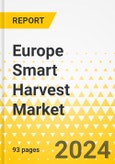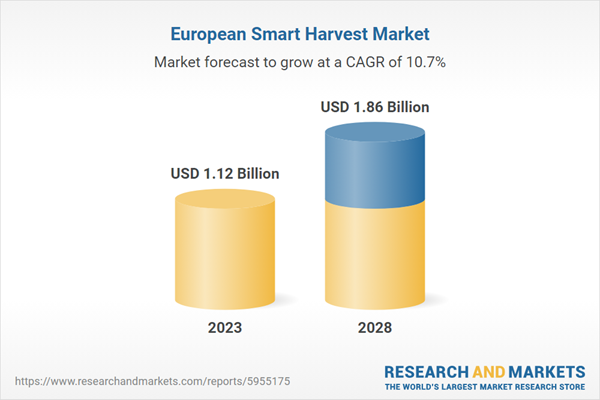This report comes with 10% free customization, enabling you to add data that meets your specific business needs.
The Europe smart harvest market (excluding U.K.) was valued at $1,121.7 million in 2023 and is anticipated to reach $1,864.4 million by 2028, witnessing a CAGR of 10.7% during the forecast period 2023-2028. This expansion is mostly driven by the agriculture industry's growing emphasis on increasing crop yields while lowering input costs. Smart harvesting systems provide accurate and focused approaches to production management, improved harvesting application, and efficient harvesting. These technologies are anticipated to fuel the growth of the worldwide smart harvest market in the next years by enabling farmers to make data-driven decisions, improve operational efficiency, decrease resource waste, and limit environmental impact.
Market Introduction
Smart harvest is a cutting-edge agricultural technology solution that has the potential to transform the farming business. This new strategy offers significant benefits to enterprises throughout the agricultural spectrum in a world where food production demands are increasing. A smart harvest system uses advanced sensors, data analytics, and automation to improve crop management and yield outcomes. It enables farmers to make informed decisions, precisely monitor crop health, and manage resources like water and fertilizer more efficiently. As a result, productivity and profitability grow while waste and environmental impact decrease.
Smart harvest enables organizations to react to changing weather conditions, market demands, and resource availability by providing real-time data insights. This technology enables sustainable and robust crop production, eventually securing the customer's bottom line, whether the customer is a small-scale operator or a major agricultural organization. Incorporating smart harvest into the customer's agricultural company not only improves operational efficiency, but it also positions the customer as an innovative and environmentally conscious industry leader.
A variety of key elements influence the market's expansion. These include the growing global food demand, the decreasing availability of water resources and arable land, the shortage of agricultural labor, and the rising trend in agricultural input costs such as harvesting labor expenses. These reasons are expected to stimulate increased use of smart harvest technology in the agriculture sector as a whole. These cutting-edge technologies enable farmers to improve resource allocation, increase crop production, and ultimately increase agricultural productivity.
Market Segmentation:
Segmentation 1: by Site of Operation
- On-Field
- Controlled Environment
Segmentation 2: by Product
- Robotic Harvester
- Self-Propelled Smart Harvester
- Others
Segmentation 3: by Country
- Germany
- France
- Italy
- Spain
- The Netherlands
- Belgium
- Switzerland
- Ukraine
- Greece
- Rest-of Europe
How can this report add value to an organization?
Product/Innovation Strategy: The product segment helps the reader to understand the different technologies used for smart harvest and their potential globally. Moreover, the study gives the reader a detailed understanding of the different solutions provided by smart harvest providers for imaging, processing, and analyzing. Compared to conventional agricultural methods, smart harvest enables more exact targeting of harvest, crop mapping, and crop growth detection, allowing farmers to save money by maximizing the use of their inputs.
Growth/Marketing Strategy: The Europe smart harvest market has seen major development by key players operating in the market, such as business expansion, partnership, collaboration, and joint venture. The favored strategy for the companies has been partnership, collaboration, and joint venture activities to strengthen their position in the global smart harvest market.
Competitive Strategy: Key players in the Europe smart harvest market analyzed and profiled in the study involve smart harvest-based product manufacturers, including market segments covered by distinct product kinds, applications served, and regional presence, as well as the influence of important market tactics employed. Moreover, a detailed competitive benchmarking of the players operating in the global smart harvest market has been done to help the reader understand how players stack against each other, presenting a clear market landscape. Additionally, comprehensive competitive strategies such as partnerships, agreements, and collaborations will aid the reader in understanding the untapped revenue pockets in the market.
Key Market Players and Competition Synopsis
The companies that are profiled have been selected based on inputs gathered from primary experts and analyzing company coverage, type portfolio, and market penetration.
Some prominent names in the market include:
- Agrobot
- AMB Rousset
This product will be delivered within 3-5 business days.
Table of Contents
Companies Mentioned
- Agrobot
- Antobot Ltd.
- AMB Rousset
- CNH Industrial N.V.
Table Information
| Report Attribute | Details |
|---|---|
| No. of Pages | 93 |
| Published | April 2024 |
| Forecast Period | 2023 - 2028 |
| Estimated Market Value ( USD | $ 1.12 Billion |
| Forecasted Market Value ( USD | $ 1.86 Billion |
| Compound Annual Growth Rate | 10.7% |
| No. of Companies Mentioned | 4 |









